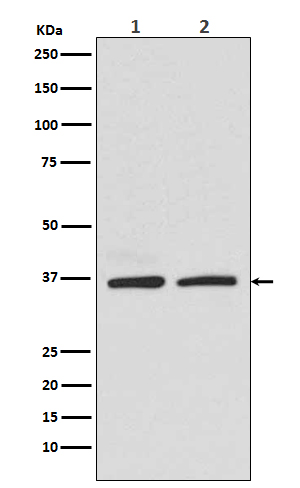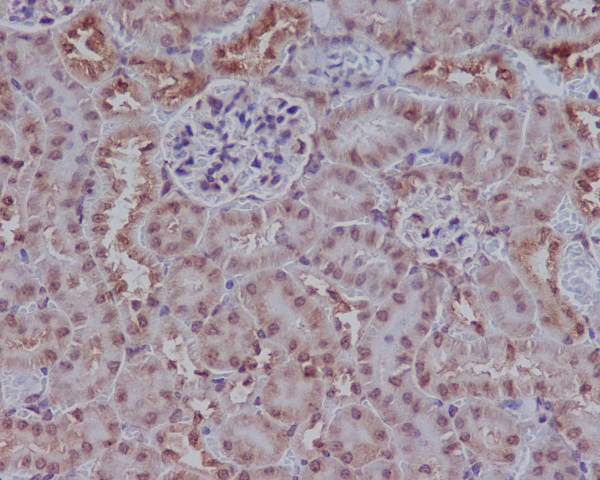

| WB | 1/500-1/1000 | Human,Mouse,Rat |
| IF | 1/20 | Human,Mouse,Rat |
| IHC | 1/50-1/100 | Human,Mouse,Rat |
| ICC | 1/50-1/200 | Human,Mouse,Rat |
| FCM | 1/50-1/100 | Human,Mouse,Rat |
| Elisa | 咨询技术 | Human,Mouse,Rat |
| Aliases | RAD51; RAD51A; RECA; DNA repair protein RAD51 homolog 1; HsRAD51; hRAD51; RAD51 homolog A |
| Entrez GeneID | 5888 |
| WB Predicted band size | Calculated MW: 37 kDa; Observed MW: 37 kDa |
| Host/Isotype | Rabbit IgG |
| Antibody Type | Primary antibody |
| Storage | Store at 4°C short term. Aliquot and store at -20°C long term. Avoid freeze/thaw cycles. |
| Species Reactivity | Human,Mouse,Rat |
| Immunogen | A synthesized peptide derived from human Rad51 |
| Formulation | Purified antibody in PBS with 0.05% sodium azide. |
+ +
以下是关于Rad51抗体的3篇参考文献(标题、作者及摘要简述):
1. **文献名称**:*Purification and characterization of human Rad51 protein, an analogue of Escherichia coli RecA*
**作者**:Sung, P.; Robberson, D.L.
**摘要**:该研究首次纯化并鉴定了人类Rad51蛋白,制备了特异性抗体,证实其在体外促进DNA链交换的能力,为后续研究Rad51在DNA修复中的功能奠定基础。
2. **文献名称**:*Homologous recombination and the repair of DNA double-strand breaks*
**作者**:West, S.C.
**摘要**:文章综述了Rad51在同源重组中的作用,重点提到通过特异性抗体检测Rad51在细胞核内形成的修复焦点(foci),作为评估同源重组活性的关键实验工具。
3. **文献名称**:*Rad51 protein involved in repair and recombination in S. cerevisiae is a RecA-like protein*
**作者**:Shinohara, A.; Ogawa, H.; Ogawa, T.
**摘要**:研究利用Rad51抗体在酵母模型中验证其与DNA损伤位点的结合,证明Rad51在减数分裂和DNA双链断裂修复中的核心作用,抗体被用于免疫沉淀和细胞定位分析。
4. **文献名称**:*Nuclear dynamics of RAD51 group proteins in response to DNA damage*
**作者**:Tarsounas, M.; Davies, A.A.; West, S.C.
**摘要**:通过Rad51抗体进行免疫荧光染色,揭示了Rad51蛋白在DNA损伤后的核内动态聚集,为研究癌症治疗中同源重组缺陷(如BRCA突变)提供实验依据。
---
注:以上文献均发表于1990-2000年代,为Rad51抗体在DNA修复机制研究中的经典应用案例,涵盖蛋白功能验证、细胞定位及疾病模型分析。
The Rad51 antibody is a crucial tool in studying the Rad51 protein, a central player in DNA repair mechanisms. Rad51 is a homolog of bacterial RecA and facilitates homologous recombination (HR), a high-fidelity pathway for repairing DNA double-strand breaks (DSBs). It orchestrates the search for homologous sequences and strand exchange between damaged and undamaged DNA, ensuring genomic stability. Dysregulation of Rad51 is linked to cancer predisposition, therapy resistance, and genetic disorders, making it a focus in oncology and molecular biology research.
Rad51 antibodies are widely used to detect Rad51 protein expression, localization, and dynamics in cells. They enable visualization of Rad51 foci formation at DNA damage sites through techniques like immunofluorescence, Western blotting, or immunohistochemistry. These antibodies help assess HR efficiency, particularly in cancers with BRCA1/2 mutations where HR deficiency influences responses to PARP inhibitors or platinum-based therapies. Researchers also utilize them to study Rad51 interactions with auxiliary proteins (e.g., BRCA2. RAD52) and its regulatory mechanisms during cell cycle progression.
Commercial Rad51 antibodies are typically raised against human or murine epitopes, requiring validation for species specificity and cross-reactivity. Their applications extend to evaluating Rad51 as a potential biomarker for cancer prognosis or treatment stratification. In basic research, these antibodies aid in dissecting HR mechanisms, replication stress responses, and chromosomal stability, providing insights into genome maintenance processes and therapeutic targeting of DNA repair pathways.
×